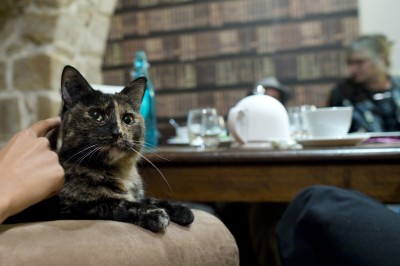
Imagine you’re sipping some deeply steeped jasmine tea, crumbling up your worries like wads of paper as you nibble a savory scone. Now imagine that 10 cats are in the same room as you. If that hairy detail enhances your fantasy, your dreams may soon be coming true.
The feasting-amidst-felines trend has already started to blossom in other countries. Since September, Parisians have enjoyed their croissants with a side of purring at Café des Chats. And it has long been a thing to pay for petting cats in the trendier neighborhoods of Osaka, Japan. America, so often on the cutting edge of blending things—See: the cronut—has been slow to combine casual dining and whisker tickles. But two San Franciscans are hoping to change that this spring.
Courtney Hatt and David Braginsky plan to open what they believe is America’s first cat café, aptly named KitTea. Their dream is to serve beverages like catnip-infused tea and let customers mingle among the animals, which will all be shelter kitties up for adoption. “What really drew me to the concept was the idea of a space that was relaxing and didn’t have a high frenetic energy like coffee houses do,” Hatt says. And, of course, the fact that she really loves cats. “If this can be successful, I think there will definitely be people who follow suit,” she says. “It’s going to be pretty big.”
So why, given Americans’ well-documented addiction to cat videos, is this not big already? Because we have health codes, for starters. Food safety inspectors generally frown upon having an abundance of loose hair in an eatery. A Boston cat café called Miaou, reported as an impending reality in 2013, has yet to open its doors at least partly because of uncertainty about legally allowing cats in a restaurant.
San Francisco has similar regulations, but the county health department says the concept could work if the fauna and biscuits are kept separate. KitTea, which is currently finalizing its location, will have to essentially run two distinct operations: a tea house and a “cat sanctuary,” as Hatt calls it, that is tea-friendly. The spaces can’t share staff, storage space, entrances, washrooms or even have so much as an adjoining door. “They cannot operate in the same physical location,” says San Francisco Department of Public Health spokesperson Colleen Chawla. “You can’t have cats in the same place as food.”
But it is possible to have them next door to each other. Hatt says she’s “confident” that they’ll get the approvals they need and says they’ll start crowdfunding the venture soon. She’s hoping that beyond selling refreshing drinks, her business will be a place where locals socialize through a common love for felines, where homeless kittens find a loving family and where humans can enjoy the therapeutic qualities of animal companionship. Cats, she says, have “their natural relieving way about them.”
And if that language reminds you of another logistical hurdle when it comes to having cats in the house, don’t fret. The litter boxes will be in kept away from the public, Hatt promises, in a space “that is very well ventilated.”
More Must-Reads from TIME
- Donald Trump Is TIME's 2024 Person of the Year
- Why We Chose Trump as Person of the Year
- Is Intermittent Fasting Good or Bad for You?
- The 100 Must-Read Books of 2024
- The 20 Best Christmas TV Episodes
- Column: If Optimism Feels Ridiculous Now, Try Hope
- The Future of Climate Action Is Trade Policy
- Merle Bombardieri Is Helping People Make the Baby Decision
Contact us at letters@time.com